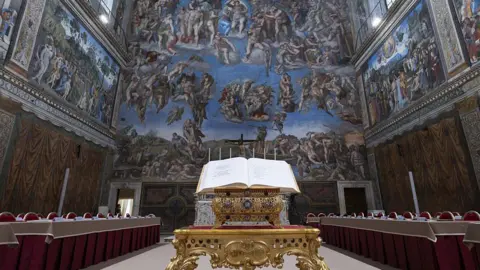The anticipation surrounding the selection of the new Pope is palpable, as 133 cardinals are poised to enter the hallowed confines of the Sistine Chapel in Vatican City. The conclave, a tradition steeped in centuries of history, is set to commence this Wednesday evening, marking a pivotal moment for the Roman Catholic Church. This election process aims to choose the successor to Pope Francis, who passed away on Easter Monday 2025 at the age of 88.
The day is scheduled to begin at 10:00 AM local time (09:00 BST) with a solemn Mass held in St. Peter’s Basilica. The ceremony will be overseen by Giovanni Battista Re, the 91-year-old Cardinal Dean, renowned for officiating Pope Francis’ funeral. This Mass is a significant spiritual foundation for the proceedings and will be broadcasted for the worldwide audience eager to witness this consequential moment.
Following the Mass, there will be a strict isolation imposed on the cardinals as mobile signals within Vatican territory will be deactivated. This measure is put in place to ensure that the cardinal electors are not influenced or contacted from the outside world during the critical process of deliberation and voting. Later in the afternoon, around 4:15 PM (3:15 PM BST), the cardinals will form a procession to the Sistine Chapel, where they will begin the conclave in earnest.
Upon entering the chapel, a collective act of devotion will take place, with the cardinals singing a liturgy and the hymn *Veni Creator*, invoking the Holy Spirit’s guidance in their decision-making. Each cardinal will then take an oath of secrecy, binding them to confidentiality regarding the inner workings of the election process. The reverence of the occasion is further emphasized by the historical context, as they will be surrounded by Michelangelo’s frescoes, a testament to the artistic and spiritual heritage of the Catholic Church.
The typical proceedings involve the recitation of “extra omnes,” a phrase meaning “everybody out,” which marks the commencement of the conclave. Although the term implies a locked situation, it is essentially a signal that no one except the essential ecclesiastical staff will remain in the chapel. The entrances to the Apostolic Palace, including the Sistine Chapel, will be sealed with lead seals ensuring complete privacy during the voting process.
As the situation unfolds, the Master of Pontifical Liturgical Celebrations, Diego Ravelli, plays a vital role by distributing ballot papers. Although electing a Pope in the first voting round is a rare occurrence, it highlights the importance of that initial vote. Austen Ivereigh, a prominent Catholic writer, articulates that the first ballot can reflect the dynamics of support among the cardinals, with votes potentially clustering around certain candidates as the process continues.
If the first vote does not yield the necessary two-thirds majority required to elect a new Pope, the cardinals will retreat to the Casa Santa Marta guesthouse for dinner. This provides them essential time to engage informally, building consensus and discussing various candidates. The atmosphere during their meals adheres to strict secrecy, with staff members sworn to confidentiality.
Cardinals will reconvene the following morning for additional voting rounds, understanding that protracted deliberation might signify significant divisions among them. Conversations and networking during meals become critical, as consensus often develops organically away from the formalities of the voting procedure.
As the cardinals deliberate, outside the chapel, thousands of the faithful gather, their eyes turned toward the chimney of St. Peter’s Basilica, eagerly awaiting the appearance of white smoke signaling that a new Pope has been chosen. The vote’s outcome not only represents the will of the cardinals but also indicates a pivotal direction for the future of the Catholic Church in an era marked by change and challenge. The conclave serves as a reminder of the Church’s commitment to continuity amidst evolving societal norms and pressures.
With these events unfolding, all eyes are set on the Vatican, where an emotional and spiritual journey will culminate in the election of the Catholic Church’s 267th Pope, poised to inspire and lead the faithful in the years to come.



